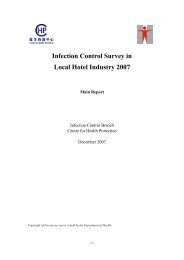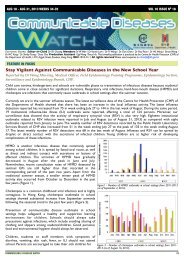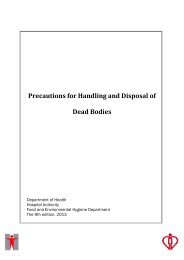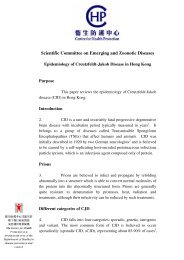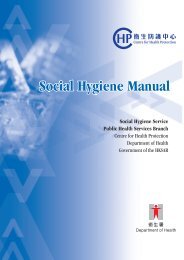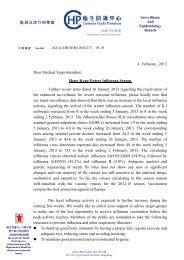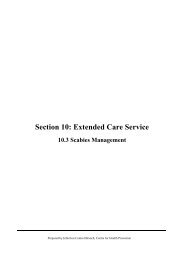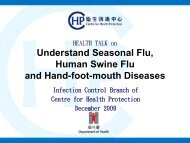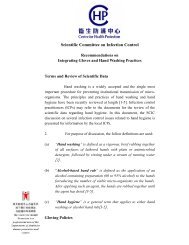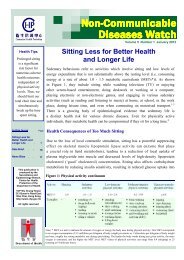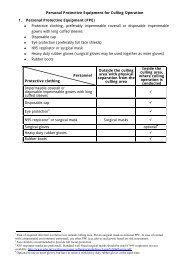Evaluation of StartSmart@school.hk Pilot Project Main Report
Evaluation of StartSmart@school.hk Pilot Project Main Report
Evaluation of StartSmart@school.hk Pilot Project Main Report
Create successful ePaper yourself
Turn your PDF publications into a flip-book with our unique Google optimized e-Paper software.
<strong>Evaluation</strong> <strong>of</strong> <strong>StartSmart@school</strong>.<strong>hk</strong><br />
<strong>Pilot</strong> <strong>Project</strong><br />
<strong>Main</strong> <strong>Report</strong><br />
Central Health Education Unit<br />
Centre for Health Protection<br />
Department <strong>of</strong> Health<br />
Government <strong>of</strong> Hong Kong Special Administrative Region<br />
January 2012<br />
Copyright <strong>of</strong> this study report is held by the Department <strong>of</strong> Health
Table <strong>of</strong> Contents<br />
Chapter 1: Introduction ...................................................................................... 3<br />
1.1 Background ............................................................................................... 3<br />
1.2 Objective <strong>of</strong> the study .............................................................................. 3<br />
Chapter 2: Methodology ..................................................................................... 4<br />
2.1 Study Design ............................................................................................. 4<br />
2.2 Target Respondents .................................................................................. 4<br />
2.3 Questionnaire Design and Data Collection Method ............................. 4<br />
2.4 <strong>Pilot</strong> Study ................................................................................................. 5<br />
2.5 Fieldwork .................................................................................................. 5<br />
2.6 Sample Size and Response Rate ............................................................. 5<br />
2.7 Quality Control ........................................................................................ 6<br />
2.8 Data Processing and Analysis ................................................................. 6<br />
Chapter 3: Findings <strong>of</strong> the Principal Survey .................................................... 7<br />
3.1 Healthy Eating .......................................................................................... 7<br />
3.2 Physical Activity ....................................................................................... 9<br />
3.3 Other health promotion activities ......................................................... 11<br />
3.4 <strong>Project</strong> Implementation ......................................................................... 11<br />
Chapter 4: Findings <strong>of</strong> the Teacher Survey .................................................... 16<br />
4.1 Background Information ....................................................................... 16<br />
4.2 Participation and Acceptability <strong>of</strong> the <strong>Pilot</strong> <strong>Project</strong> ........................... 17<br />
4.3 Feasibility <strong>of</strong> the <strong>Pilot</strong> <strong>Project</strong> ............................................................... 19<br />
4.4 Effectiveness <strong>of</strong> the <strong>Pilot</strong> <strong>Project</strong> .......................................................... 21<br />
Chapter 5: Findings <strong>of</strong> the Parent Survey ...................................................... 24<br />
5.1 Background Information ....................................................................... 24<br />
5.2 Participation and Acceptability <strong>of</strong> the <strong>Pilot</strong> <strong>Project</strong> ........................... 24<br />
5.3 Feasibility <strong>of</strong> the <strong>Pilot</strong> <strong>Project</strong> ............................................................... 26<br />
5.4 Effectiveness <strong>of</strong> the <strong>Pilot</strong> <strong>Project</strong> .......................................................... 28<br />
Chapter 6: Findings <strong>of</strong> the Meal Arrangement/ Preparation Staff Survey . 30<br />
6.1 Birthday Party Arrangements .............................................................. 30<br />
6.2 Foods for Meal Preparation .................................................................. 30<br />
Chapter 7: Conclusions and Recommendations............................................. 33<br />
7.1 Discussion and conclusion ..................................................................... 33<br />
7.2 Limitations .............................................................................................. 34<br />
7.3 Recommendations .................................................................................. 35<br />
References .......................................................................................................... 36<br />
Acknowledgements ............................................................................................ 37<br />
Appendix – Questionnaires............................................................................... 39<br />
Page 2
Chapter 1: Introduction<br />
1.1 Background<br />
Childhood obesity is a significant public health problem in Hong Kong. The obesity<br />
rate for Primary One students has risen from 11.3% in 1996/97 to 16.6% in 2009/10.<br />
As the average weight at birth remained stable over the same period, it could<br />
reasonably be inferred that the overweight problem had started as early as preschool<br />
age. In this connection, the Department <strong>of</strong> Health (DH) has conducted a series <strong>of</strong><br />
studies to identify possible positive or negative influence on healthy eating and<br />
physical activity in the pre-primary institutions (PPIs). Based on these research<br />
findings, DH launched the <strong>StartSmart@school</strong>.<strong>hk</strong> <strong>Pilot</strong> <strong>Project</strong> (<strong>Pilot</strong> <strong>Project</strong>) in the<br />
2010/11 school year.<br />
The objective <strong>of</strong> the <strong>Pilot</strong> <strong>Project</strong> was to improve the knowledge towards healthy<br />
eating and physical activity among school personnels, food providers, parents and<br />
care-givers; as well as to create a supportive environment for healthy lifestyle in PPIs.<br />
The pilot project targeted both KGs and KG-cum-CCCs and 30 PPIs enrolled in the<br />
<strong>Pilot</strong> <strong>Project</strong>. In order to support PPIs in implementing the project, a number <strong>of</strong><br />
promotional materials and educational resources were designed, produced and<br />
disseminated to pilot schools.<br />
With experience gained from the <strong>Pilot</strong> <strong>Project</strong>, the programme will be finetuned and<br />
extended to all PPIs in Hong Kong. Questionnaires surveys were proposed for use<br />
in evaluating the pilot project. The Social Sciences Research Centre (SSRC) <strong>of</strong> the<br />
University <strong>of</strong> Hong Kong was commissioned to conduct this evaluation study (Study).<br />
1.2 Objective <strong>of</strong> the study<br />
To evaluate the feasibility, acceptability and effectiveness <strong>of</strong> the <strong>Pilot</strong> <strong>Project</strong> in PPIs.<br />
Page 3
Chapter 2: Methodology<br />
2.1 Study Design<br />
This was a cross-sectional study and all 30 PPIs participating in the <strong>Pilot</strong> <strong>Project</strong> were<br />
invited to take part in the Study.<br />
2.2 Target Respondents<br />
Four groups <strong>of</strong> target respondents in this Study included:<br />
� All principals or supervisors <strong>of</strong> the PPIs<br />
� All teachers <strong>of</strong> the PPIs<br />
� All parents <strong>of</strong> students who were studying in the PPIs<br />
� Meal arrangement/ preparation staff <strong>of</strong> PPIs<br />
2.3 Questionnaire Design and Data Collection Method<br />
Four sets <strong>of</strong> structured self-administered questionnaires in Chinese were developed<br />
for each <strong>of</strong> the target groups <strong>of</strong> the Study. The respective questionnaires covered<br />
the following areas:<br />
Principal questionnaire (consisted <strong>of</strong> 14 questions)<br />
(i) School policies and participation in health promotion activities;<br />
(ii) Feasibility and acceptability <strong>of</strong> the <strong>Pilot</strong> <strong>Project</strong>; and<br />
(iii) Effectiveness <strong>of</strong> the <strong>Pilot</strong> <strong>Project</strong>.<br />
Teacher questionnaire (consisted <strong>of</strong> 11 questions)<br />
(i) Participation and acceptability <strong>of</strong> the <strong>Pilot</strong> <strong>Project</strong>;<br />
(ii) Feasibility <strong>of</strong> the <strong>Pilot</strong> <strong>Project</strong>; and<br />
(iii) Effectiveness <strong>of</strong> the <strong>Pilot</strong> <strong>Project</strong>.<br />
Parent questionnaire (consisted <strong>of</strong> 10 questions)<br />
(i) Participation and acceptability <strong>of</strong> the <strong>Pilot</strong> <strong>Project</strong>;<br />
(ii) Feasibility <strong>of</strong> the <strong>Pilot</strong> <strong>Project</strong>; and<br />
(iii) Effectiveness <strong>of</strong> the <strong>Pilot</strong> <strong>Project</strong>.<br />
Page 4
Meal arrangement staff questionnaire (consisted <strong>of</strong> 17 questions)<br />
(i) Arrangement <strong>of</strong> school birthday party; and<br />
(ii) Preparation <strong>of</strong> daily food for preschool students.<br />
SSRC was responsible for the liaison with 30 participating PPIs on distribution and<br />
collection <strong>of</strong> all questionnaires and the subsequent analysis <strong>of</strong> data.<br />
2.4 <strong>Pilot</strong> Study<br />
A pilot study was conducted between 8 and 14 June 2011 to test the length, logic,<br />
wording and format <strong>of</strong> the questionnaires. A total <strong>of</strong> 13 teachers and 30 parents<br />
participated in the pilot study. Based on feedback and comments from respondents<br />
and investigators received, the questionnaires were modified for use in the Study.<br />
Moreover, data collected from the pilot study were excluded from analysis in the<br />
Study.<br />
2.5 Fieldwork<br />
Questionnaires were distributed to all 30 PPIs between 20 and 24 June 2011.<br />
Completed questionnaires were collected by SSRC before 25 July 2011. However,<br />
as one PPI had problem organizing completion and return <strong>of</strong> questionnaires, it had to<br />
be excluded from the Study.<br />
2.6 Sample Size and Response Rate<br />
Among the 5,603 distributed questionnaires, 4,010 questionnaires were completed<br />
and returned. The number <strong>of</strong> questionnaires returned and the corresponding<br />
response rate in each target group are shown below (Table 2.1).<br />
Table 2.1 Numbers <strong>of</strong> questionnaires returned and the corresponding response<br />
rate in four target groups<br />
No. <strong>of</strong> questionnaire No. <strong>of</strong> questionnaire Response rate<br />
disseminated<br />
returned<br />
Principal 29 26 89.7%<br />
Teacher 292 244 83.6%<br />
Parent 5,251 3,714 70.7%<br />
Meal Arrangement Staff 29 26 89.7%<br />
Page 5
2.7 Quality Control<br />
To ensure the quality <strong>of</strong> data collected, at least 15% <strong>of</strong> the questionnaires completed<br />
<strong>of</strong> each category <strong>of</strong> questionnaires were checked independently. After that, all data<br />
were subject to range and logical checking. Unclear and illogical answers were<br />
replaced by missing or logical values.<br />
2.8 Data Processing and Analysis<br />
Prior to analysis, re-coding and reclassification <strong>of</strong> the data were carried out where<br />
necessary. Some categories <strong>of</strong> variables were combined into smaller categories to<br />
ensure that the counts would not be too small. Descriptive statistics and qualitative<br />
results for all questions in the four questionnaires were compiled. SPSS for<br />
Windows version 12.0 was used for data analysis. Any missing data were excluded<br />
from analysis. Percentages presented in this report were rounded to one decimal<br />
place and hence some might not add up to 100%.<br />
Page 6
Chapter 3: Findings <strong>of</strong> the Principal Survey<br />
3.1 Healthy Eating<br />
3.1.1 School policies<br />
Among all principals, 88.5% <strong>of</strong> them claimed that they had already established a<br />
healthy eating policy in school but only one <strong>of</strong> them (4.3%) had a written<br />
documentation in place (Table 3.1). Among those PPIs with healthy eating policy,<br />
more than half (52.2%) reported that a working group dedicated to formulate or<br />
implement the healthy eating policy at school had been formed (Table 3.2).<br />
Membership <strong>of</strong> these working groups was confined to principals and teachers. No<br />
parent was involved.<br />
Table 3.1 Establishment <strong>of</strong> healthy eating policy in PPIs<br />
No. <strong>of</strong> respondents %<br />
Yes 23 88.5%<br />
With written documentation 1 4.3%<br />
Without written documentation 22 95.7%<br />
No 3 11.5%<br />
Base: All prinicpals = 26<br />
Table 3.2 Dedicate a working group to formulate or implement healthy eating<br />
policy<br />
No. <strong>of</strong> respondents %<br />
Yes 12 52.2%<br />
No 11 47.8%<br />
Base: All PPIs which had established healthy eating policy = 23<br />
3.1.2 Factors on food selection<br />
Factors considered and their order <strong>of</strong> importance when arranging meals for preschool<br />
students are listed in Table 3.3. “Nutritional value” and “Food hygiene” were the two<br />
most commonly quoted factors by school principals.<br />
Page 7
Table 3.3 Factors to consider and their order <strong>of</strong> importance when arranging<br />
meals for preschool children<br />
No. <strong>of</strong> PPI considered the factors as important<br />
Most<br />
important<br />
Second<br />
important<br />
Third<br />
important<br />
Nutritional value 16 (66.7%) 7 (31.8%) 1 (4.8%)<br />
Food hygiene 8 (33.3%) 13 (59.1%) 2 (9.5%)<br />
Price 0 1 (4.5%) 6 (28.6%)<br />
Convenience to purchase 0 1 (4.5%) 0<br />
Preference <strong>of</strong> student 0 0 10 (47.6%)<br />
Parent’s opinion 0 0 2 (9.5%)<br />
Base: All principals =24 (excluding missing)<br />
* Multiple answers are allowed<br />
3.1.3 Nutritional Guidelines for Children Aged 2 to 6 Years<br />
Majority <strong>of</strong> principals (92.0%) reported that the Nutritional Guidelines for Children<br />
Aged 2 to 6 Years (Nutritional Guidelines) provided practical information for teaching<br />
staff to incorporate in school activities (Table 3.4). In addition, four-fifths (80.0%) <strong>of</strong><br />
principals agreed the ways suggested in the Guidelines for encouraging home-school<br />
cooperation to improve healthy eating habits were workable (Table 3.5).<br />
Table 3.4 Feasibility <strong>of</strong> the teaching staff to incorporate the Nutritional Guideline<br />
in school activities<br />
No. <strong>of</strong> respondents %<br />
Feasible 23 92.0%<br />
Not feasible 0 0<br />
No comment 2 8.0%<br />
Base: All prinicpals = 25 (excluding missing)<br />
Table 3.5 Feasibility <strong>of</strong> implementing the suggestion <strong>of</strong> home-school<br />
cooperation in the Nutritional Guidelines<br />
No. <strong>of</strong> respondents %<br />
Feasible 20 80.0%<br />
Not feasible 2 8.0%<br />
No comment 3 12.0%<br />
Base: All principals = 25 (excluding missing)<br />
Page 8
Among the 23 PPIs that had established healthy eating policy at PPIs, most (91.3%)<br />
had followed the suggestion <strong>of</strong> the Nutritional Guidelines when formulating or<br />
modifying their school policies (Table 3.6).<br />
Table 3.6 Follow the Nutritional Guidelines to formulate or modify healthy eating<br />
school policy<br />
No. <strong>of</strong> respondents %<br />
Yes 21 91.3%<br />
No 2 8.7%<br />
Base: All PPIs which had established healthy eating policy = 23<br />
3.2 Physical Activity<br />
3.2.1 School policies<br />
Most principals (92.0%) reported that they had already established a physical activity<br />
school policy and 17.4% <strong>of</strong> them had a written document in place (Table 3.7).<br />
Among those PPIs with physical activity policy, 52.2% reported that a working group<br />
dedicated to formulate and implement the policy had been formed (Table 3.8).<br />
Similar to healthy eating policy, membership <strong>of</strong> this working group was confined to<br />
principals and teachers.<br />
Table 3.7 Establishment <strong>of</strong> physical activity policy in PPIs<br />
No. <strong>of</strong> respondents %<br />
Yes 23 92.0%<br />
With written documentation 4 17.4%<br />
Without written documentation 19 82.6%<br />
No 2 8.0%<br />
Base: All prinicpals = 25 (excluding missing)<br />
Table 3.8 Dedicate a working group to formulate or implement physical activity<br />
policy<br />
No. <strong>of</strong> respondents %<br />
Yes 12 52.2%<br />
No 11 47.8%<br />
Base: All PPIs which had established physical activity policy = 23<br />
Page 9
3.2.2 Physical Activity Guide for Children Aged 2 to 6 Years<br />
Most <strong>of</strong> the principals (84.0%) reported that the Physical Activity Guide for Children<br />
Aged 2 to 6 Years (Physical Activity Guide) provided practical information for teaching<br />
staff to incorporate in school activities (Table 3.9). For those who did not agree, their<br />
comments included:<br />
� The teaching schedule <strong>of</strong> half-day PPIs was too tight to implement the<br />
recommendation; and<br />
� The recommendation <strong>of</strong> time spent on physical activity was too long per day.<br />
Table 3.9 Feasibility <strong>of</strong> the teaching staff to incorporate the Physical Activity<br />
Guide into school activities<br />
No. <strong>of</strong> respondents %<br />
Feasible 21 84.0%<br />
Not feasible 2 8.0%<br />
No comment 2 8.0%<br />
Base: All principals = 25 (excluding missing)<br />
Similarly, 84.0% <strong>of</strong> principals agreed the ways suggested in the Physical Activity<br />
Guide for encouraging home-school cooperation to improve the physical activity<br />
habits <strong>of</strong> preschool students were workable (Table 3.10).<br />
Table 3.10 Feasibility <strong>of</strong> implementing the suggestion <strong>of</strong> home-school<br />
cooperation in the Physical Activity Guide<br />
No. <strong>of</strong> respondents %<br />
Feasible 21 84.0%<br />
Not feasible 1 4.0%<br />
No comment 3 12.0%<br />
Base: All principals = 25 (excluding missing)<br />
Among the 23 PPIs that had established physical activity policy at PPIs, majority<br />
(91.3%) had followed the suggestion in the Physical Activity Guide when formulating<br />
or modifying their school policies (Table 3.11).<br />
Table 3.11 Follow the Physical Activity Guide to formulate or modify the<br />
physical activity policy<br />
No. <strong>of</strong> respondents %<br />
Yes 21 91.3%<br />
No 2 8.7%<br />
Base: All PPIs which had established physical acitivty policy = 23<br />
Page 10
For those who did not follow the Guidelines, the reasons were:<br />
� Our school already has guidelines for internal use.<br />
� We do not fully understand the contents <strong>of</strong> the Phsyical Activity Guide.<br />
3.3 Other health promotion activities<br />
Principals were asked if their PPIs had participated or organized healthy eating or<br />
physical activity promotional activity during the <strong>Pilot</strong> <strong>Project</strong> period. Two-thirds <strong>of</strong><br />
them (66.7%) responded to have organized or participated in at least one healthy<br />
eating or physical activity promotional activity in the school year 2010/11. These<br />
activities included:<br />
� Fruit Day;<br />
� Series <strong>of</strong> in-house activities on healthy eating (e.g. healthy birthday, healthy picnic,<br />
healthy snacks tasting, recipes design competitions);<br />
� Sports day;<br />
� Exercise session with parents; and<br />
� Health talks for parents (organised by commercial companies).<br />
However, 33.3% <strong>of</strong> PPIs did not participate in or conduct any activity to promote<br />
healthy eating or physical activity in school year 2010/11.<br />
3.4 <strong>Project</strong> Implementation<br />
3.4.1 Behavioural change <strong>of</strong> students on healthy eating and physical activity<br />
More than four-fifths <strong>of</strong> principals (83.3%) had noticed that the dietary habits <strong>of</strong> their<br />
students had improved in school year <strong>of</strong> 2010/2011 (Table 3.12). Improvements<br />
commonly quoted were:<br />
� Less picky-eating/ willing to try different types <strong>of</strong> foods;<br />
� Eat more fruit and vegetables;<br />
� Drink more water;<br />
� Bring healthy snacks to birthday parties; and<br />
� Increase interest in healthy food.<br />
At the same time, some principals found that knowledge <strong>of</strong> their students had<br />
increased.<br />
Page 11
Regarding physical activity practices, 60.9% <strong>of</strong> principals had noticed improvements<br />
among students (Table 3.12). The main improvements included:<br />
� Do more exercise/ willing to do various types <strong>of</strong> exercise;<br />
� Developed a habit <strong>of</strong> doing exercise;<br />
� Do exercise with parents; and<br />
� Increase interest in doing exercises.<br />
Table 3.12 Improvement on healthy eating and physical activity practices <strong>of</strong><br />
preschool children in school year 2010/2011<br />
Have Do not have<br />
No comment<br />
improvement improvement<br />
(i) Healthy eating 20 (83.3%) 1 (4.2%) 3 (12.5)<br />
(ii) Physical activity 14 (60.9%) 4 (17.4%) 5 (21.7%)<br />
Base: All principals =24 for (i) and 23 for (ii) (excluding missing)<br />
3.4.2 Satisfaction with the <strong>Pilot</strong> <strong>Project</strong><br />
Principals were asked the degree <strong>of</strong> satisfaction towards different components <strong>of</strong> the<br />
<strong>Pilot</strong> <strong>Project</strong>.<br />
(i) Communication between DH and participating PPIs<br />
Majority <strong>of</strong> principals (96.0%) were satisfied with communication between DH and the<br />
school during project implementation. One principal was not satisfied because<br />
information provided by DH was not clear.<br />
(ii) Provision <strong>of</strong> resources<br />
Regarding provision <strong>of</strong> resources, 91% expressed satisfaction. One principal<br />
pointed out that quality <strong>of</strong> the <strong>Pilot</strong> <strong>Project</strong> banner was poor as it deteriorated quickly.<br />
Page 12
(iii) Staff training<br />
Most <strong>of</strong> the principals (96%) were satisfied with the training provided to teaching staff.<br />
For those who were dissatisfied, their views and suggestions included:<br />
� Only a small number <strong>of</strong> teaching staff could attend the training workshops<br />
� Suggest organizing more training sessions on the same topic(s) at different<br />
locations and on different dates.<br />
� Suggest that training sessions should be organised on school holidays so that<br />
more staff can attend.<br />
(iv) Programme Arrangement<br />
All principals were satisfied with the logistics <strong>of</strong> the programme implementation.<br />
(v) Parent education<br />
Most <strong>of</strong> principals (87.0%) were satisfied with parent education components <strong>of</strong> the<br />
<strong>Pilot</strong> <strong>Project</strong>. For those who were dissatisfied, their concerns and suggestions<br />
included:<br />
� The venues <strong>of</strong> various educational activities might not be convenient for parents<br />
coming from various locations. It turned out that only a small number <strong>of</strong> parents<br />
could attend the health talks; and<br />
� More health talks on the same topic(s) could be organized at different districts<br />
and on different dates (even held in evenings) so that working parents could<br />
attend as well.<br />
(vi) Overall comment<br />
Overall, majority <strong>of</strong> principals (96.0%) were satisfied with the overall programme. Only<br />
one principal was not satisfied with the overall programme.<br />
Page 13
Figure 3.1 Level <strong>of</strong> satisfaction with the implementation <strong>of</strong> the Startsmart<br />
@school.<strong>hk</strong> <strong>Pilot</strong> <strong>Project</strong><br />
Base: All principals (i) Programme arrangement=24, (ii) Staff training=25, (iii) Communication between<br />
DH and participating PPIs=25, (iv) Provision <strong>of</strong> resources=23, (v) Parent education=24, and (iv)<br />
Overall=24) (excluding missing)<br />
3.4.3 Difficulty encountered during the <strong>Pilot</strong> <strong>Project</strong><br />
More than one-third <strong>of</strong> principals (37.5%) pointed out that they had encountered<br />
difficulty when participating in the <strong>Pilot</strong> <strong>Project</strong> (Table 3.12). Difficulty quoted by<br />
principals included:<br />
� Need more time to prepare healthy food and relevant teaching materials;<br />
� Difficult to invite parents to participate in the activities;<br />
� Workload <strong>of</strong> teachers increased; and<br />
� Lack <strong>of</strong> clear guidelines/ pr<strong>of</strong>essional advice from the <strong>Project</strong> Team.<br />
Table 3.12 Encountered difficulty when implementing the <strong>Pilot</strong> <strong>Project</strong><br />
No. <strong>of</strong> respondents %<br />
Yes 9 37.5%<br />
No 9 37.5%<br />
No comment 6 25.0%<br />
Base: All principals = 24 (excluding missing)<br />
Page 14
3.4.4 Acceptability <strong>of</strong> the <strong>Pilot</strong> <strong>Project</strong><br />
Majority <strong>of</strong> principals (91.7%) indicated that the resources including manpower, time<br />
and money incurred in their PPIs to implement the <strong>Pilot</strong> <strong>Project</strong> was acceptable (Table<br />
3.13). Moreover, 92.0% agreed that the <strong>Pilot</strong> <strong>Project</strong> could help preschool students<br />
develop healthy eating habits and physical activity practices (Table 3.14).<br />
Table 3.13 Consider the resources including manpower, time, and money<br />
incurred in their PPIs for implementing the <strong>Pilot</strong> <strong>Project</strong> was acceptable<br />
No. <strong>of</strong> respondents %<br />
Yes 22 91.7%<br />
No 0 0<br />
No comment 2 8.3%<br />
Base: All principals = 24 (excluding missing)<br />
Table 3.14 Agree the <strong>Pilot</strong> <strong>Project</strong> can help preschools students develop healthy<br />
eating habits and physical activity practice<br />
No. <strong>of</strong> respondents %<br />
Yes 23 92.0%<br />
No 2 8.0%<br />
Base: All principals = 25 (excluding missing)<br />
In addition, more than three quarters <strong>of</strong> principals (76.0%) would recommend the<br />
<strong>StartSmart@school</strong>.<strong>hk</strong> <strong>Project</strong> to other PPIs (Table 3.15).<br />
Table 3.15 The <strong>Pilot</strong> <strong>Project</strong> could be recommended to other PPIs in future<br />
No. <strong>of</strong> respondents %<br />
Yes 19 76.0%<br />
No 0 0<br />
No comment 6 24.0%<br />
Base: All principals = 25 (excluding missing)<br />
Page 15
Chapter 4: Findings <strong>of</strong> the Teacher Survey<br />
4.1 Background Information<br />
A total <strong>of</strong> 244 copies <strong>of</strong> teacher questionnaires were collected from 29 PPIs. More<br />
than two-fifths <strong>of</strong> respondents (41.1%) were responsible for half-day classes. 14.4%<br />
<strong>of</strong> teachers were responsible for arrangement and design <strong>of</strong> students’ meal, while<br />
85.6% <strong>of</strong> teachers were involved in planning and/or organizing students’ physical<br />
activity (Table 4.1).<br />
Table 4.1 Background information <strong>of</strong> the teachers<br />
No. <strong>of</strong><br />
respondents<br />
Type <strong>of</strong> classes<br />
Full-day class 36 15.3%<br />
Half-day class 97 41.1%<br />
Mixed 103 43.6%<br />
Involvement in students’ diet*<br />
Arrange and design students’ meal 34 14.4%<br />
Involve in formulating healthy eating policy 32 13.6%<br />
Purchase food ingredients/ prepare the<br />
meals<br />
%<br />
14 5.9%<br />
Others 32 13.6%<br />
Involvement in students’ physical activity*<br />
Arrange and provide guidance on students’<br />
physical activity<br />
202 85.6%<br />
Design students’ physical activity 164 69.5%<br />
Involve in formulating physical activity policy 70 29.7%<br />
Others 5 2.1%<br />
Base: All teachers (excluding missing)<br />
* Multiple answers are allowed<br />
Page 16
4.2 Participation and Acceptability <strong>of</strong> the <strong>Pilot</strong> <strong>Project</strong><br />
4.2.1 Participation<br />
Teachers were asked their participation or involvement in various aspects <strong>of</strong> the <strong>Pilot</strong><br />
<strong>Project</strong>. About three quarters <strong>of</strong> teachers had read the Nutritional Guidelines (75.8%)<br />
and Physical Activity Guide (80.0%). Less than half <strong>of</strong> teachers had attended any<br />
workshop <strong>of</strong> the <strong>Pilot</strong> <strong>Project</strong> (40.3%) or visited the <strong>StartSmart@school</strong>.<strong>hk</strong> website<br />
(44.6%) (Table 4.2).<br />
Table 4.2 Participation or involvement in various activities <strong>of</strong> the <strong>Pilot</strong> <strong>Project</strong><br />
No. <strong>of</strong><br />
respondents<br />
(i) Had read the Nutritional Guidelines 169 75.8%<br />
(ii) Had read the Physical Activity Guide 184 80.0%<br />
(iii) Had attended any teacher workshop <strong>of</strong> the <strong>Pilot</strong><br />
<strong>Project</strong><br />
%<br />
95 40.3%<br />
(iv) Had visited the <strong>Pilot</strong> <strong>Project</strong> website 95 44.6%<br />
Base: All teachers=223 for (i), 230 for (ii), 236 for (iii) and 213 for (iv) (excluding missing)<br />
4.2.2 Acceptability<br />
(i) Nutritional Guidelines for Children Aged 2-6<br />
For those teachers who had read the Nutritional Guidelines, over 80% found it easy to<br />
read and understand (88.6%) and considered sufficient topics had been covered<br />
(82.6%). Moreover, 78.9% <strong>of</strong> teachers found the information in the Nutritional<br />
Guidelines explained in good details (Table 4.3). For those who commented the<br />
Nutritional Guidelines was not easy to read and understand, did not cover sufficient<br />
topics, or the information was not explained in good details, their suggestions or<br />
comments were:<br />
� Information about measuring food ingredients were complicated with some not<br />
applicable in the school setting;<br />
� Some standards listed in the Nutritional Guidelines were different from<br />
information provided by Social Welfare Department;<br />
� Only limited choice <strong>of</strong> snacks for students was provided in the Nutritional<br />
Guidelines;<br />
� Suggested providing more recipes to enrich the content.<br />
Page 17
Table 4.3 Comments on the Nutritional Guidelines<br />
Yes No No comment<br />
(i) Easy to read and understand 148 (88.6%) 2 (1.2%) 17 (10.2%)<br />
(ii) Sufficient topics covered 138 (82.6%) 2 (1.2%) 27 (16.2%)<br />
(iii) Explained in good details 131 (78.9%) 1 (0.6%) 34 (20.5%)<br />
Base: All teachers who had read the Nutritional Guidelines =167 for (i) & (ii) and 166 for (iii) (excluding<br />
missing)<br />
(ii) Physical Activity Guide for Children Aged 2-6<br />
Among teachers who had read the Physical Activity Guide, most teachers (93.9%)<br />
claimed that was easy to read and understand and considered sufficient topics had<br />
been covered. Moreover, 77.7% teachers found the information provided in the<br />
Guide explained in good details (Table 4.4).<br />
Table 4.4 Comments on the Physical Activity Guide<br />
Yes No No comment<br />
(i) Easy to read and understand 168 (93.9%) 11 (6.1%) 0<br />
(ii) Sufficient topics covered 151 (84.4%) 3 (1.7%) 25 (14.0%)<br />
(iii) Explained in good details 139 (77.7%) 3 (1.2%) 37 (20.7%)<br />
Base: All teachers who had read the Physical Activity Guide =179 (excluding missing)<br />
For those teachers who felt the Physical Activity Guide was not easy to read or<br />
understand, did not cover sufficient topics, or the information was not explained in<br />
good details, their suggestions or comments were:<br />
� The Guide provided limited options <strong>of</strong> physical activities for parents to practice<br />
with their children;<br />
� Suggest including some related websites with topics <strong>of</strong> physical activity for<br />
preschool children; and<br />
� Suggest introducing more physical activities suitable for preschool children.<br />
(iii) Website<br />
For those teachers who had visited the website <strong>of</strong> the <strong>Pilot</strong> <strong>Project</strong><br />
(www.startsmart.gov.<strong>hk</strong>), more than four-fifths (83.3%) found the website user-friendly.<br />
Specifically, over 80% <strong>of</strong> teachers claimed that topics on healthy eating habits and<br />
physical activity practice were sufficient and explained in good details (Table 4.5).<br />
Page 18
Table 4.5 Comments on the website <strong>of</strong> <strong>Pilot</strong> <strong>Project</strong><br />
Yes No No comment<br />
(i) User-friendly 75 (83.3%) 1 (1.1%) 14 (15.6%)<br />
(ii) Cover sufficient topics<br />
Healthy eating habits 80 (88.9%) 2 (2.2%) 8 (8.9%)<br />
Physical activity practice 75 (83.3%) 1 (1.1%) 14 (15.6%)<br />
(iii) Explained in good details<br />
Healthy eating habits 74 (82.2%) 16 (17.8%) 0<br />
Physical activity practice 73 (81.1%) 1 (1.1%) 16 (17.8%)<br />
Base: All teachers who had visited the website = 90 (excluding missing)<br />
4.3 Feasibility <strong>of</strong> the <strong>Pilot</strong> <strong>Project</strong><br />
4.3.1 Applied knowledge gained from the <strong>Pilot</strong> <strong>Project</strong> in teaching<br />
Most <strong>of</strong> the teachers (95.4%) reported that they had applied the knowledge <strong>of</strong> healthy<br />
eating gained from the <strong>Pilot</strong> <strong>Project</strong> in teaching (Table 4.6). Knowledge on “Healthy<br />
Birthday Party” and “Fruit Day” had been incorporated into different school activities.<br />
They also provided more water and fruit to students.<br />
Table 4.6 Applied knowledge <strong>of</strong> healthy eating gained from the <strong>Pilot</strong> <strong>Project</strong> in<br />
teaching<br />
No. <strong>of</strong> respondents %<br />
Yes 188 95.4%<br />
No 9 4.6%<br />
Base: All teachers who had (i) read the Nuritional Guidelines, OR (ii) read the Physical Activity Guide,<br />
OR (iii) Attend teachers workshops, OR (iv) visit website = 197 (excluding missing)<br />
On the other hand, 16.3% <strong>of</strong> teachers had encountered difficulty during the application<br />
process (Table 4.7).<br />
Table 4.7 Encountered difficulty when applying knowledge <strong>of</strong> healthy eating<br />
gained from the <strong>Pilot</strong> <strong>Project</strong> in teaching<br />
No. <strong>of</strong> respondents %<br />
Yes 23 16.3%<br />
No 118 83.7%<br />
Base: All teachers who had applied knowledge <strong>of</strong> healthy eating gained from the <strong>Pilot</strong> <strong>Project</strong> in<br />
teaching =141 (excluding missing)<br />
Page 19
Common difficulty encountered included:<br />
� Insufficient time;<br />
� Increased workload;<br />
� Limited choice <strong>of</strong> reward for preschool children; and<br />
� Expensive to buy fruit on a frequent basis.<br />
Similar to healthy eating practices, 96.4% <strong>of</strong> teachers reported that they had applied<br />
knowledge <strong>of</strong> physical activity practices gained from the <strong>Pilot</strong> <strong>Project</strong> in their practice<br />
(Table 4.8).<br />
Table 4.8 Applied knowledge <strong>of</strong> physical activity gained from the <strong>Pilot</strong> <strong>Project</strong> in<br />
teaching<br />
No. <strong>of</strong> respondents %<br />
Yes 190 96.4%<br />
No 7 3.6%<br />
Base: All teachers who had (i) read the Nuritional Guidelines, OR (ii) read the Physical Activity Guide,<br />
OR (iii) Attend teachers workshops, OR (iv) visit website = 197 (excluding missing)<br />
However, 13.1% <strong>of</strong> teachers reported that they had encountered difficulty during the<br />
process <strong>of</strong> implementation (Table 4.9).<br />
Table 4.9 Encountered difficulty when applying knowledge <strong>of</strong> physical activity<br />
gained from the <strong>Pilot</strong> <strong>Project</strong> in teaching<br />
No. <strong>of</strong> respondents %<br />
Yes 19 13.2%<br />
No 125 86.8%<br />
Base: All teachers who had applyed knowledge <strong>of</strong> physical activity gained from the <strong>Pilot</strong> <strong>Project</strong> in<br />
teaching = 144 (excluding missing)<br />
Common difficulties encountered included:<br />
� Lack <strong>of</strong> relevant teaching materials;<br />
� Limited space to do exercise; and<br />
� Insufficient time to promote physical activity in PPIs.<br />
4.3.2 Home-school Cooperation<br />
About three quarters <strong>of</strong> teachers found that it was practical to follow the suggestions<br />
<strong>of</strong> the guidebooks to encourage home-school cooperation for improving healthy<br />
Page 20
eating habits (76.3%) and physical activity practice (75.4%) <strong>of</strong> preschool students<br />
(Table 4.10). However, there were teachers who considered the Nutritional<br />
Guidelines and the Physical Activity Guide not practical. The reasons given<br />
included:<br />
� Difficult to verify if parents had followed the guidelines at home;<br />
� Parents might not be knowledgeable in monitoring the quality <strong>of</strong> food provided to<br />
preschool students;<br />
� Parents might not read or follow the guidelines to prepare food for their children<br />
outside the school;<br />
� Difficult for parents to practice physical activity everyday with their children;<br />
� Parents lack motivation in doing exercise; and<br />
� Parents are busy.<br />
Table 4.10 Feasibility to follow the suggestion <strong>of</strong> home-school collaboration in<br />
the Guidelines<br />
Yes No No comment<br />
(i) Healthy eating 134 (79.8%) 2 (1.2%) 32 (19.0%)<br />
(ii) Physical activity 144 (79.1%) 8 (4.4%) 30 (16.5%)<br />
Base: All teachers who had (i) read the Nutrition Guidelines = 168, and (ii) read the Physical Activity<br />
Guide = 182 (excluding missing)<br />
4.4 Effectiveness <strong>of</strong> the <strong>Pilot</strong> <strong>Project</strong><br />
Majority <strong>of</strong> teachers (91.8%) noticed that the dietary habits <strong>of</strong> their students had<br />
improved in the last half year. The key changes included eating more fruit and<br />
vegetables, drinking more water and less picky-eating. Regarding physical activity<br />
practices, 88.0% <strong>of</strong> teachers reported that they had found improvements. These<br />
included doing more exercise, doing more physical activities <strong>of</strong> different types, and<br />
increasing interests in doing exercise.<br />
Table 4.11 Improvement <strong>of</strong> dietary habits and physical activity practices <strong>of</strong><br />
preschool students<br />
Yes No No comment<br />
(i) Healthy eating 223 (91.8%) 4 (1.6%) 16 (6.6%)<br />
(ii) Physical activity 213 (88.0%) 9 (3.7%) 20 (8.3%)<br />
*Base: All teachers = 243 for (i) and 242 for (ii) (excluding missing)<br />
Page 21
Teachers were also asked their comments on effectiveness <strong>of</strong> various interventions in<br />
the <strong>Pilot</strong> <strong>Project</strong> in improving dietary habits and physical activity practices <strong>of</strong> preschool<br />
students.<br />
In general, about 80% <strong>of</strong> teachers considered that the <strong>Pilot</strong> <strong>Project</strong> was effective<br />
(75.9%) and very effective (3.0%) in facilitating teachers to improve dietary and<br />
physical activity practices <strong>of</strong> preschool children.<br />
About 80% <strong>of</strong> teachers found the teacher workshops (82.6%), Nutritional Guidelines<br />
(79.1%) and Physical Activity Guide (79.6%) were effective in helping teachers to<br />
improve dietary and physical activity practices <strong>of</strong> preschool children. About 75% <strong>of</strong><br />
teachers commented that the website <strong>of</strong> <strong>Pilot</strong> <strong>Project</strong> (76.1%) and souvenirs such as<br />
“fruit towels” (76.5%) were effective in facilitating teachers to improve the dietary and<br />
physical activity practices <strong>of</strong> preschool children (Figure 2).<br />
Figure 2 Effectiveness <strong>of</strong> the Startsmart @school.<strong>hk</strong> <strong>Pilot</strong> <strong>Project</strong><br />
Base: (i) Teachers who had attended teaching workshops=92, (ii) Teachers who had read the Physical<br />
Activity Guide=176, (iii) Teachers who had read Nutritional Guidelines=163, (iv) All teachers=192, (v)<br />
Teacher who had visited the Website =88, (vi) All teachers who were involved in at least one <strong>of</strong> the<br />
activity from (i) to (v)= 199 (all excluding missing)<br />
Over 60% <strong>of</strong> teachers (60.2%) stated to have no difficulty in implementing the <strong>Pilot</strong><br />
<strong>Project</strong> in PPIs (Table 4.12).<br />
Page 22
Table 4.12 Difficulty encountered during the overall programme<br />
No. <strong>of</strong> respondents %<br />
Yes 23 11.2%<br />
No 124 60.2%<br />
No comment 59 28.6%<br />
Base: All teachers who had (i) read the Nuritional Guidelines, OR (ii) read the Physical Activity Guide,<br />
OR (iii) Attend teachers workshops, OR (iv) visit website = 206 (excluding missing)<br />
For those who had encountered difficulty in the <strong>Pilot</strong> <strong>Project</strong>, their comments included:<br />
� The duration <strong>of</strong> the <strong>Pilot</strong> <strong>Project</strong> is short;<br />
� Too much workload and lack <strong>of</strong> time;<br />
� Inadequate related teaching materials; and<br />
� Difficult to have parents’ support<br />
Nearly all teachers (99%) would recommend other preschools to join the<br />
<strong>StartSmart@school</strong>.<strong>hk</strong> <strong>Project</strong> in future.<br />
Page 23
Chapter 5: Findings <strong>of</strong> the Parent Survey<br />
5.1 Background Information<br />
Among the 3714 parent questionnaires, about 80% were completed by mothers while<br />
16% were by fathers. 69.0% <strong>of</strong> respondents had a child attending half-day class while<br />
the remaining had a child attending full-day class (31.0%) (Table 5.1).<br />
Table 5.1 Background information <strong>of</strong> the parents<br />
Relationship with children<br />
No <strong>of</strong> respondents %<br />
Father 595 16.2%<br />
Mother 2913 79.2%<br />
Others 168 4.6%<br />
Type <strong>of</strong> class <strong>of</strong> children<br />
Full-time 1143 31.0%<br />
Half-time 2548 69.0%<br />
Base: All parents =3714 (excluding missing)<br />
5.2 Participation and Acceptability <strong>of</strong> the <strong>Pilot</strong> <strong>Project</strong><br />
5.2.1 Participation<br />
About two-thirds <strong>of</strong> parents (64.0%) had read the “Nutritional and Physical Activity<br />
Guide for Parents and Carers” (Parent Guide), while over half <strong>of</strong> the parents had read<br />
the “Letter-to-Parents” (56.2%) or used the Physical Activity Card for Children (58.6%)<br />
respectively. At the same time, only 13.3% and 23.6% <strong>of</strong> parents had attended the<br />
parent’s talk <strong>of</strong> the <strong>Pilot</strong> <strong>Project</strong> or visited the website <strong>of</strong> <strong>Pilot</strong> <strong>Project</strong> respectively<br />
(Table 5.2).<br />
Page 24
Table 5.2 Participation or involvement in various activities <strong>of</strong> the <strong>Pilot</strong> <strong>Project</strong><br />
No <strong>of</strong><br />
respondents<br />
%<br />
Had read the Nutritional and Physical Activity Guide 2269 64.0%<br />
Had attended the parent health talks <strong>of</strong> the <strong>Pilot</strong><br />
<strong>Project</strong><br />
442 13.3%<br />
Had visited the <strong>Pilot</strong> <strong>Project</strong> website 794 23.6%<br />
Had read “Letter-to-Parents” 1943 56.2%<br />
Had used the Physical Activity Card for Children 2026 58.6%<br />
Base = All parents (excluding missing)<br />
5.2.2 Acceptability<br />
(i) Nutritional and Physical Activity Guide for Parents and Carers<br />
About three quarters <strong>of</strong> parents (75.5%) claimed the Parent Guide was easy to read<br />
and understand. Over 60% <strong>of</strong> parents agreed that the topics covered in the Parent<br />
Guide were sufficient in terms <strong>of</strong> healthy eating habits (69.8%) and physical activity<br />
practice (65.9%). In addition, two-third <strong>of</strong> parents found the information on healthy<br />
eating habits (66.9%) and physical activity practices (62.7%) in the Parent Guide<br />
explained in good details.<br />
Table 5.3 Comments on the Nutritional and Physical Activity Guide for Parents<br />
and Carers<br />
Yes No No comment<br />
(i) Easy to read and understand 1597 (75.5%) 34 (1.6%) 483 (22.8%)<br />
(ii) Sufficient topic<br />
Healthy eating habits 1456 (69.8%) 37 (1.8%) 592 (28.4%)<br />
Physical activity practice 1348 (65.9%) 29 (1.4%) 670 (32.7%)<br />
(iii) Detailed information<br />
Healthy eating habits 1403 (66.9%) 33 (1.6%) 661 (31.5%)<br />
Physical activity practice 1282 (62.7%) 27 (1.3%) 736 (36.0%)<br />
Base = All teachers who had read the Nutritional and Physical Activity Guide for Parents and Carers =<br />
2113 for (i), 2085 for (ii), and 2097 for (iii)<br />
Regarding the Parent Guide, parents had the following comments and suggestions:<br />
� Suggest to enrich the content :<br />
� More practical information on the diet <strong>of</strong> preschool children (e.g. recipes and<br />
appropriate ingredients);<br />
� More types <strong>of</strong> physical activities or courses suitable for children;<br />
� Calorie calculation;<br />
Page 25
� Location <strong>of</strong> public recreational facilities; and<br />
� Advantages and safety guidelines for doing physical activities for preschool<br />
children;<br />
� Suggest reducing the content <strong>of</strong> the Parent Guide; and<br />
� Use more pictures.<br />
(ii) Website for the <strong>Pilot</strong> <strong>Project</strong><br />
Over 60% <strong>of</strong> respondents who had visited the website <strong>of</strong> the <strong>Pilot</strong> <strong>Project</strong> agreed that<br />
the website was user friendly (64.7%). As to its content, over 60% reported that the<br />
topics covered were sufficient for healthy eating (65.4%) and physical activity practice<br />
(66.1%). Moreover, 65.9% and 62.7% <strong>of</strong> respondents found that the information on<br />
healthy eating and physical activity explained in good details (Table 5.4).<br />
Table 5.4 Comments on the Website <strong>of</strong> the <strong>Pilot</strong> <strong>Project</strong><br />
Yes No No comment<br />
(i) User friendly 468 (64.7%) 30 (4.1%) 225 (31.1%)<br />
(ii) Sufficient topic<br />
Healthy eating habits 471 (65.4%) 19 (2.6%) 230 (31.9%)<br />
Physical activity practice 470 (66.1%) 10 (1.4%) 231 (32.5%)<br />
(iii) Detailed information<br />
Healthy eating habits 474 (65.9%) 14 (1.9%) 231 (32.1%)<br />
Physical activity practice 445 (62.7%) 10 (1.4%) 255 (35.9%)<br />
Base = All parents who had visited the website = 723 for (i), 720 for (ii) and 719 for (iii)<br />
5.3 Feasibility <strong>of</strong> the <strong>Pilot</strong> <strong>Project</strong><br />
5.3.1 Letter–to-Parents<br />
For those parents who had read the Letter-to-Parents, most (85.6%) had engaged<br />
their preschool children in the games or activities (Table 5.5).<br />
Table 5.5 Engaged children in the games or activities provided in<br />
Letter-to-Parents<br />
No. <strong>of</strong> respondents %<br />
Yes 1512 85.6%<br />
No 255 14.4%<br />
Base: All parents who had read the “Letters-to-Parents” = 1767 (excluding missing)<br />
Page 26
5.3.2 Physical Activity Card for Children<br />
For those parents who had used the Physical Activity Card, about 80% found it useful<br />
in encouraging their children to do more physical activity (Table 5.6).<br />
Table 5.6 Agree the Physical Activity Card for Children is useful in encouraging<br />
children to do more physical activity<br />
No. <strong>of</strong> respondents %<br />
Yes 1523 80.2%<br />
No 51 2.7%<br />
No Comment 326 17.2%<br />
Base: All parents who had used the Physical Activity Card = 1900 (excluding missing)<br />
5.3.3 Applied learning to improve children’s behaviour at home<br />
After acquiring more health knowledge via multiple means under the <strong>Pilot</strong> <strong>Project</strong>,<br />
about half <strong>of</strong> parents stated they have applied what they learnt to improve children’s<br />
dietary habits (50.5%) and physical activity (48.9%) at home (Table 5.7).<br />
Table 5.7 Applied the learning to improve children’s behaviour at home<br />
Yes No No comment<br />
Healthy eating habits 1312 (50.5%) 431 (16.6%) 857 (33.0%)<br />
Physical activity practice 1271 (48.9%) 454 (17.5%) 874 (33.6%)<br />
Base: All parents who had (i) read the Parent Guide, OR (ii) Attended parents’ talk, OR (iii) visited<br />
the <strong>Pilot</strong> <strong>Project</strong> website, (iv) read the “letters-to-parent’, OR (v) had used the Physical Actvity Card=<br />
2600 (excluding missing)<br />
Actions that parents would commonly take included:<br />
For diet:<br />
� Ask children to drink more water and less unhealthy drinks;<br />
� <strong>Main</strong>tain balanaced diet and regular time for every meal;<br />
� Provide different kinds <strong>of</strong> fruit, vegetables and healthy food items at home;<br />
� Provide less unhealthy food to children; and<br />
� Educate children about healthy diet and food nutrition.<br />
Page 27
For physical activity<br />
� Bring children to parks or outdoor areas;<br />
� Arrange a greater variety <strong>of</strong> physical activities for children;<br />
� Help children develop regular exercise practice; and<br />
� Do exercise with children more frequently.<br />
5.4 Effectiveness <strong>of</strong> the <strong>Pilot</strong> <strong>Project</strong><br />
About three quarters <strong>of</strong> parents (74.8%) had found that dietary habits <strong>of</strong> their children<br />
had improved in the last half year. Key improvements included eating more fruit and<br />
vegetables, drinking more water and less picky-eating. Similarly, for physical activity<br />
habits, 74.7% <strong>of</strong> parents reported that they noticed improvements among their<br />
children. The improvements included doing more exercise, doing more physical<br />
activities in different types, and increasing interest in doing exercise (Table 5.8).<br />
Table 5.8 Improvement <strong>of</strong> dietary habits and physical activity practices <strong>of</strong> the<br />
preschool children in the last half year<br />
Yes No No comment<br />
Healthy eating habits 2278 (74.8%) 687 (18.5%) 248 (6.7%)<br />
Physical activity practice 2717 (74.7%) 604 (16.6%) 315 (8.7%)<br />
Base = All parents (excluding missing)<br />
Around two-thirds <strong>of</strong> parents suggested that the <strong>Pilot</strong> <strong>Project</strong> was effective (60.5%) or<br />
very effective (7.5%) in facilitating them to improve dietary and physical activity<br />
practices <strong>of</strong> their children. On the other hand, some parents commented that it was<br />
ineffective (1.5%) or very ineffective (0.2%) in facilitating them to do so.<br />
Over 70% <strong>of</strong> respondents found the health talks for parents (72.7%) and Physical<br />
Activity Card for Children (75.6%) effective or very effective in helping parents<br />
improve practices <strong>of</strong> their children in dietary and physical activity at home. Over 60%<br />
<strong>of</strong> respondents commented the Parent Guide (67.4%), website (67.3%) and Letter to<br />
Parents (68.3%) were effective or very effective in facilitating parents to improve<br />
dietary and physical activity practices <strong>of</strong> their children (Figure 3).<br />
Page 28
Figure 3 Effectiveness <strong>of</strong> the Startsmart@school.<strong>hk</strong> <strong>Pilot</strong> <strong>Project</strong><br />
Base: (i) Parents who had attended health talk =381, (ii) Parents who had read the Parent Guide=1861,<br />
(iii) Parents who had visited the Website =667, (iv) Parents who had used Letter-to-Parents = 1635, (v)<br />
Parents who had used Physical Activity Card =1779, (v) All parents who had been involved any one <strong>of</strong><br />
the activity from (i) to (v)= 2199 (all excluding missing)<br />
Page 29
Chapter 6: Findings <strong>of</strong> the Meal Arrangement/ Preparation Staff<br />
Survey<br />
6.1 Birthday Party Arrangements<br />
From the response <strong>of</strong> meal arrangement staff, 60% indicated that their PPIs had given<br />
advice to parents regarding the type <strong>of</strong> food to bring for school birthday parties.<br />
Moreover, majority <strong>of</strong> PPIs (92.0%) provided fresh fruit to students.<br />
For food items provided by PPIs, the commonest items were cakes (89.4%), water<br />
(57.9%), drinks other than water (42.2%) and fruit (31.6%). The commonest food<br />
brought by parents to birthday parties were fruit (28%), snacks (24%), cakes (20%), as<br />
well as biscuits and cookies (16%).<br />
Staff was also asked the birthday gifts that they distributed at the last birthday party.<br />
The commonest choices <strong>of</strong> the gifts were toys (73%), fruit (50%), stationery (46%) and<br />
boiled eggs (42%).<br />
6.2 Foods for Meal Preparation<br />
Regarding meal preparation for preschool students, the practices and choices <strong>of</strong> food<br />
ingredients adopted by meal planners are described below (Table 6.1):<br />
� All respondents reported that they would remove the skin on poultry or fat on<br />
meat before cooking. Besides, all respondents would not provide deep-fried<br />
food (e.g. pre-processed deep-fried foods like bean curd stick, bean curd puff and<br />
e-fu noodle, etc) to students;<br />
� About three quarters <strong>of</strong> respondents (73.9%) would not use fatty cut <strong>of</strong> meat,<br />
processed or canned meat (e.g. chicken with skin, ham, imitated crabmeat,<br />
sausages, barbecued pork and textured vegetable protein, etc) as the cooking<br />
ingredients <strong>of</strong> the menu (including the ingredients for fried rice or fried noodle);<br />
� About 70% <strong>of</strong> respondents (70.8%) would not use dehydrated, canned or<br />
preserved fruit / vegetables, or those with added sugar (e.g. sweetened raisins,<br />
canned fruit in syrup, canned mushrooms and Chinese preserved vegetables, etc)<br />
Page 30
as cooking ingredients <strong>of</strong> the menu;<br />
� Half <strong>of</strong> respondents would use full-cream or condensed dairy products (e.g.<br />
full-cream milk, chocolate milk, fruit flavored milk, full-fat cheese, full-fat<br />
yogurt/yogurt drinks, condensed milk and evaporated milk, etc) as ingredients <strong>of</strong><br />
the meals;<br />
� Near 80% <strong>of</strong> respondents (79.2%) would not use MSG, chicken powder, salty<br />
flavorings or instant sauces (e.g. bean sauce, fish sauce, fermented red bean<br />
curd, Tariyaki sauce, white sauce, ketchup or sauces that make <strong>of</strong> canned soup,<br />
etc) during cooking; and<br />
� Besides water, nearly three quarters <strong>of</strong> PPIs (73.9%) would provide some drinks<br />
(e.g. Horlicks, Ovaltine and soybean milk, etc) to students. Among them, 42.9%<br />
would add sugar into the drinks and 58.8% would add full-cream milk.<br />
Table 6.1 Practice for food preparation in PPIs<br />
Remove the skins on poultries or fats on meat<br />
removed before cooking<br />
Do not provide deep-fried food<br />
Do not use fatty cut <strong>of</strong> meat, processed or canned<br />
meat as the cooking ingredients <strong>of</strong> the menu<br />
Do not use dehydrated, canned or preserved fruit /<br />
vegetables, with added sugar as cooking ingredients<br />
<strong>of</strong> the menu<br />
Do not use MSG, chicken powder, salty flavorings or<br />
instant sauces during cooking<br />
Do not use full-cream or condensed dairy products<br />
Yes No<br />
26 (100.0%) 0<br />
26 (100.0%) 0<br />
6 (26.1%) 17 (73.9%)<br />
7 (29.2%) 17 (70.8%)<br />
19 (79.2%) 5 (20.8%)<br />
12 (50.0%) 12 (50.0%)<br />
Provide other drinks rather than water 17 (73.9%) 6 (26.1%)<br />
Add sugar into drinks 6 (42.9%) 8 (57.1%)<br />
Add full-cream milk into the drinks 10 (58.8%) 7 (41.2%)<br />
Base = All meal arrangement staff (excluding missing)<br />
When they prepared fried rice or fried noodles, 65.3% <strong>of</strong> them would use less than<br />
two teaspoons <strong>of</strong> oil for cooking. At the same time, most <strong>of</strong> the respondents (80.7%)<br />
would use less than two teaspoons <strong>of</strong> oil for cooking each main course (Table 6.2).<br />
Page 31
Table 6.2 Use <strong>of</strong> oil for cooking<br />
Use less than two teaspoons <strong>of</strong> oil<br />
for cooking fried rice or noodles<br />
Use less than two teaspoons <strong>of</strong> oil<br />
for cooking each main course<br />
Base: All meal arrangement staff=26<br />
Yes No No comment/<br />
NA<br />
17 (65.3%) 1 (3.8%) 8 (30.8%)<br />
21 (80.7%) 0 5 (19.2%)<br />
The commonest oil used were corn oil (41.4%) and canola oil (37.9%), while the<br />
commonest spreads used on bread were jam (33.3%) and peanut butter (28.9%).<br />
Page 32
Chapter 7: Conclusions and Recommendations<br />
7.1 Discussion and conclusion<br />
The evaluation showed that overall effectiveness <strong>of</strong> the <strong>Pilot</strong> <strong>Project</strong> was high.<br />
Principals and teachers were generally satisfied with the overall programme. Most<br />
important, many respondents (especially teachers) reported that there were<br />
improvements in dietary habits and physical activity practices among preschool<br />
students after <strong>Pilot</strong> <strong>Project</strong> implementation. Pre-primary institutions played an<br />
important role in fostering good eating habits in young children. In fact, close to 90%<br />
<strong>of</strong> children aged 3 to 5 years living in Hong Kong attended and spent significant<br />
amounts <strong>of</strong> time at PPIs. They consumed up to two meals, sometimes three, plus<br />
snacks. At the same time, they had many different movements for recreation and<br />
physical activity. 1 In order to facilitate preschool students to eat healthily, to be more<br />
active, and to develop lifelong habits, schools should work together with policymakers,<br />
parents, communities and other relevant stakeholders to create a supportive<br />
environment in the school setting.<br />
Parents and family members play an important role in their children’ eating and<br />
exercise habits. However, only around half <strong>of</strong> parents expressed that they had<br />
applied the knowledge acquired from the <strong>Pilot</strong> <strong>Project</strong> into their daily life to modify<br />
their chidlren’ diet and physical activity habits. Positive associations between<br />
preschool childhood obesity and certain aspects <strong>of</strong> parenting (such as restricting<br />
access to foods and pressuring to eat, low level parental nutritional knowledge, low<br />
levels <strong>of</strong> parental modeling <strong>of</strong> healthy eating) had been documented. 2-5 Effective<br />
two-way communication between schools and family for preschool children could be<br />
established and fostered. Various means to inform, engage and mobilize parental<br />
support for healthy eating and physical activity promotion should be continuously<br />
explored.<br />
The evaluation demonstrated that various intervention products and related health<br />
education materials were considered effective by the teachers and parents.<br />
Specifically, the Nutritional Guidelines and Physical Activity Guide were found to be<br />
Page 33
useful. Majority <strong>of</strong> teachers had read the Guidelines and their feedback was<br />
positive. However, less than half <strong>of</strong> the teachers and less than a quarter <strong>of</strong> the<br />
parents had ever visited the website <strong>of</strong> the <strong>Pilot</strong> <strong>Project</strong>. As using website to<br />
disseminate health information could be more timely and more convenient, further<br />
promotion <strong>of</strong> the website should be explored in future.<br />
Food provided in the PPIs was generally healthy, except for a few unhealthy practices<br />
commonly reported by schools(for example, providing full-cream dairy products to<br />
preschool students). To protect students from the adverse effect <strong>of</strong> unhealthy food<br />
items, schools are advised to take proactive steps to minimise the use <strong>of</strong> unhealthy<br />
ingredients in preparing school meals. In this regard, incorporating the “Nutritional<br />
Guidelines for Children Aged 2-6” (Nutritional Guidelines) in food preparation and<br />
ongoing monitoring <strong>of</strong> the food quality are recommended.<br />
Lastly, most teachers did not encounter any difficulty in implementing the <strong>Pilot</strong> <strong>Project</strong><br />
and majority <strong>of</strong> principals considered that the resources incurred by the <strong>Pilot</strong> <strong>Project</strong><br />
were acceptable. Also, extension <strong>of</strong> the <strong>Pilot</strong> <strong>Project</strong> to other PPIs was<br />
recommended by most principals and nearly all teacher respondents. It is<br />
considered both feasible and acceptable to implement the <strong>StartSmart@school</strong>.<strong>hk</strong><br />
<strong>Project</strong> in all PPIs in Hong Kong.<br />
7.2 Limitations<br />
Data in this evaluation were collected using self-administered questionnaires. The<br />
information provided by the respondents could not be verified and some respondents<br />
might give socially desirable answers which might not reflect their true attitude and<br />
behaviour.<br />
The study was <strong>of</strong> a cross-sectional nature and hence the causal relationship between<br />
variables could not be ascertained. In addition, voluntary completion <strong>of</strong> the<br />
questionnaires might lead to non-response bias. Besides, characteristics <strong>of</strong><br />
non-respondents were unknown. Some respondents might not have completed all<br />
questions in the questionnaires or might have answered the questions selectively.<br />
Page 34
7.3 Recommendations<br />
1. The <strong>StartSmart@school</strong>.<strong>hk</strong> <strong>Pilot</strong> <strong>Project</strong> was considered to be effective,<br />
acceptable and feasible in improving dietary habits and physical activity practices<br />
among preschool students. Further extension <strong>of</strong> the project to all PPIs in the<br />
future is recommended.<br />
2. Future implementation <strong>of</strong> the <strong>StartSmart@school</strong>.<strong>hk</strong> <strong>Pilot</strong> <strong>Project</strong>, in form <strong>of</strong> a<br />
<strong>StartSmart@school</strong>.<strong>hk</strong> Campaign, can take reference from the groundwork<br />
carried out in the <strong>Pilot</strong> <strong>Project</strong> with respect to the content <strong>of</strong> health education<br />
materials and logistic arrangements.<br />
3. Various means to encourage home-school cooperation should continue to be<br />
explored. Parents’ education and mass publicity should be enhanced and<br />
strengthened.<br />
Page 35
References<br />
1. Story M, Kaphingst K, French S. The Role <strong>of</strong> Schools in Obesity Prevention. The<br />
Future <strong>of</strong> Children (2006); 16(1), pp. 109-42.<br />
2. Rhee KE. Childhood Overweight and the Relationship between Parent Behaviors,<br />
Parenting Style, and Family Functioning. Annals <strong>of</strong> the American Academy <strong>of</strong><br />
Political and Social Science (2008); Jan; 615(1),p.11-37.<br />
3. Farrow CV, Blissert J. Controlling feeding practices: cause or consequence <strong>of</strong><br />
early child weight? Pediatrics (2008);121(1): e164-9.<br />
4. Brown R, Ogden J. Children’s eating attitudes and behavior: a study <strong>of</strong> the<br />
modeling and control theories <strong>of</strong> parental influence. Health Educ Res<br />
(2004);19:p.261-71.<br />
5. Gibson EL, Wardle J, Watts CJ. Fruit and vegetable consumption, nutritional<br />
knowledge and beliefs in mothers and children. Appetite (1998);31;p.205-28.<br />
Page 36
Acknowledgements<br />
We would like to thank the following pre-primary institutions for their participation in<br />
the study (school names listed in alphabetical order).<br />
Name <strong>of</strong> schools<br />
1 Ching Chung Hing Tung Kindergarten<br />
青松興東幼稚園<br />
2 Christian and Missionary Alliance Church Tai Wo Kindergarten<br />
基督教宣道會太和幼稚園<br />
3 Christian and Missionary Alliance Church Verbena Kindergarten<br />
基督教宣道會茵怡幼稚園<br />
4 Christian Evangelical Centre Lok Fu Kindergarten<br />
基督教佈道中心樂富幼稚園<br />
5 Deborah Anglo-Chinese Kindergarten (Whampoa Garden)<br />
德寶中英文幼稚園 (黃埔花園)<br />
6 ELCHK Cheung Wah Kindergarten<br />
基督教香港信義會祥華幼稚園<br />
7 Faith Lutheran Church Kindergarten<br />
深信堂幼稚園<br />
8 HKFYG Ching Lok Kindergarten (Ching Lok Nursery)<br />
香港青年協會青樂幼稚園 青樂幼兒園<br />
9 HKSPC Cheung Sha Wan Nursery School<br />
香港保護兒童會長沙灣幼兒學校<br />
10 HKSPC Hong Kong Bank Foundation Nursery School<br />
香港保護兒童會匯豐銀行慈善基金幼兒學校<br />
11 HKSPC Park'N Shop Staff Charitable Fund Nursery School<br />
香港保護兒童會百佳員工慈善基金幼兒學校<br />
12 HKYWCA Athena Kindergarten<br />
香港基督教女青年會宏恩幼稚園<br />
13 Ho Tak Kindergarten and Child Care Centre (Sponsored by Sik Sik Yuen)<br />
嗇色園主辦可德幼稚園及幼兒中心<br />
14 Ho Yan Kindergarten (Sponsored by Sik Sik Yuen)<br />
嗇色園主辦可仁幼稚園<br />
15 Lok Sin Tong Tang Tak Lim Kindergarten<br />
樂善堂鄧德濂幼稚園<br />
16 May Nga Kindergarten (Branch)<br />
美雅幼稚園 (分校)<br />
17 MCC Little Angel (Tin Shing) Kindergarten<br />
基督教聖約教會小天使(天盛)幼稚園<br />
Page 37
18 Mink International Pre-School<br />
明雅國際幼兒學校<br />
19 N.T. Women & Juveniles Welfare Association Ltd. Yuen Long Children Garden<br />
新界婦孺福利會元朗兒童樂園<br />
20 PLK Fung Leung Kit Memorial Kindergarten<br />
保良局馮梁結紀念幼稚園<br />
21 Semple Kindergarten<br />
深培中英文幼稚園<br />
22 Spring View Kindergarten<br />
欣苗幼稚園<br />
23 St Anthony's Anglo-Chinese Primary School and kindergarten<br />
聖安多尼中英文小學暨幼稚園<br />
24 St Monica's Anglo-Chinese Kindergarten (Lei Tung)<br />
聖文嘉中英文幼稚園 (利東)<br />
25 St Philip Lutheran Church Kindergarten<br />
路德會聖腓力堂幼稚園<br />
26 S.T.F.A. Tuen Mun Leung Lee Sau Yu Kindergarten<br />
順德聯誼總會屯門梁李秀娛幼稚園<br />
27 Telford Garden Kindergarten<br />
德福幼稚園<br />
28 Topkids Anglo-Chinese Kindergarten<br />
德怡中英文幼稚園<br />
29 Tsui Lam Estate Baptist Kindergarten<br />
翠林邨浸信會幼稚園<br />
30 TWGHs Chan King Har Kindergarten<br />
東華三院馬陳景霞幼稚園<br />
Page 38
Appendix – Questionnaires<br />
Page 39
Page 40
Page 41
Page 42
Page 43
Page 44
Page 45
Page 46
Page 47



